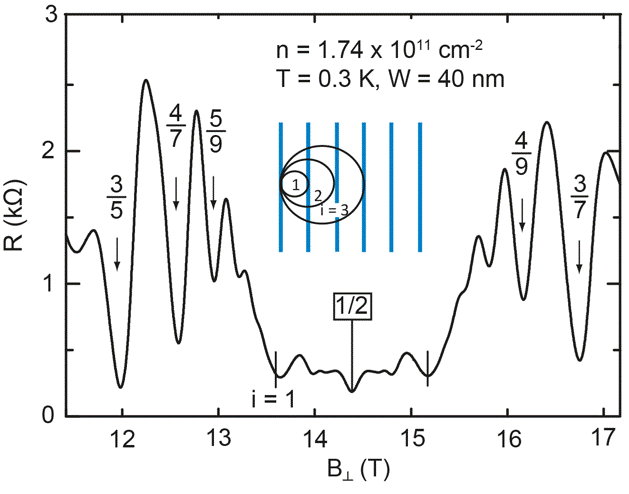 | ||
Possible anti pfaffian pairing of composite fermions at filling factor 3 8 sudhansu s mandalo
A composite fermion is the bound state of an electron and an even number of quantized vortices, sometimes visually pictured as the bound state of an electron and, attached, an even number of magnetic flux quanta. Composite fermions were originally envisioned in the context of the fractional quantum Hall effect, but subsequently took on a life of their own, exhibiting many other consequences and phenomena.
Contents
- Possible anti pfaffian pairing of composite fermions at filling factor 3 8 sudhansu s mandalo
- Prof dr hab in arkadiusz w js composite fermions and topological quantum liquids
- Description
- Experimental manifestations
- Fermi sea
- Cyclotron orbits
- Cyclotron resonance
- Shubnikov de Haas oscillations
- Integer quantum Hall effect
- Fractional quantum Hall effect
- Superconductivity
- Excitons
- Spin
- Effective magnetic field
- Mass
- Theoretical formulations
- Trial wave functions
- ChernSimons field theory
- References
Vortices are an example of topological defect, and also occur in other situations. Quantized vortices are found in type II superconductors, called Abrikosov vortices. Classical vortices are relevant to the Berezenskii–Kosterlitz–Thouless transition in two-dimensional XY model.
Prof dr hab in arkadiusz w js composite fermions and topological quantum liquids
Description
When electrons are confined to two dimensions, cooled to very low temperatures, and subjected to a strong magnetic field, their kinetic energy is quenched due to Landau level quantization. Their behavior under such conditions is governed by the Coulomb repulsion alone, and they produce a strongly correlated quantum liquid. Experiments have shown that electrons minimize their interaction by capturing quantized vortices to become composite fermions. The interaction between composite fermions themselves is often negligible to a good approximation, which makes them the physical quasiparticles of this quantum liquid.
The signature quality of composite fermions, which is responsible for the otherwise unexpected behavior of this system, is that they experience a much smaller magnetic field than electrons. The magnetic field seen by composite fermions is given by
where
Sometimes it is said that electrons "swallow"
The behavior of composite fermions is similar to that of electrons in an effective magnetic field
The minus sign occurs when the effective magnetic field is antiparallel to the applied magnetic field, which happens when the geometric phase from the vortices overcompensate the Aharonov–Bohm phase.
Experimental manifestations
The main statement of composite fermion theory is that the strongly correlated electrons at a magnetic field
Fermi sea
The effective magnetic field for composite fermions vanishes for
Cyclotron orbits
As the magnetic field is moved slightly away from
Cyclotron resonance
In addition to the cyclotron orbits, cyclotron resonance of composite fermions has also been observed by photoluminescence.
Shubnikov de Haas oscillations
As the magnetic field is moved further away from
Integer quantum Hall effect
With further increase in
Combined with
which are obtained by attaching vortices to holes in the lowest Landau level, these constitute the prominently observed sequences of fractions. Examples are
The fractional quantum Hall effect of electrons is thus explained as the integer quantum Hall effect of composite fermions. It results in fractionally quantized Hall plateaus at
with
Fractional quantum Hall effect
The above sequences exhaust most, but not all, observed fractions. Other fractions have been observed, which arise from a weak residual interaction between composite fermions, and are thus more delicate. A number of these are understood as fractional quantum Hall effect of composite fermions. For example, the fractional quantum Hall effect of composite fermions at
Superconductivity
An even denominator fraction,
Excitons
The neutral excitations of various fractional quantum Hall states are excitons of composite fermions, that is, particle hole pairs of composite fermions. The energy dispersion of these excitons has been measured by light scattering and phonon scattering.
Spin
At high magnetic fields the spin of composite fermions is frozen, but it is observable at relatively low magnetic fields. The fan diagram of the composite fermion Landau levels has been determined by transport, and shows both spin-up and spin-down composite fermion Landau levels. The fractional quantum Hall states as well as composite fermion Fermi sea are also partially spin polarized for relatively low magnetic fields.
Effective magnetic field
The effective magnetic field of composite fermions has been confirmed by the similarity of the fractional and the integer quantum Hall effects, observation of Fermi sea at half filled Landau level, and measurements of the cyclotron radius.
Mass
The mass of composite fermions has been determined from the measurements of: the effective cyclotron energy of composite fermions; the temperature dependence of Shubnikov–de Haas oscillations; energy of the cyclotron resonance; spin polarization of the Fermi sea; and quantum phase transitions between states with different spin polarizations. Its typical value in GaAs systems is on the order of the electron mass in vacuum. (It is unrelated to the electron band mass in GaAs, which is 0.07 of the electron mass in vacuum.)
Theoretical formulations
Much of the experimental phenomenology can be understood from the qualitative picture of composite fermions in an effective magnetic field. In addition, composite fermions also lead to a detailed and accurate microscopic theory of this quantum liquid. Two approaches have proved useful.
Trial wave functions
The following trial wave functions embody the composite fermion physics:
Here
Comparisons with exact results show that these wave functions are quantitatively accurate. They can be used to compute a number of measurable quantities, such as the excitation gaps and exciton dispersions, the phase diagram of composite fermions with spin, the composite fermion mass, etc. For
Chern–Simons field theory
Another formulation of the composite fermion physics is through a Chern–Simons field theory, wherein flux quanta are attached to electrons by a singular gauge transformation. At the mean field approximation the physics of free fermions in an effective field is recovered. Perturbation theory at the level of the random phase approximation captures many of the properties of composite fermions.
